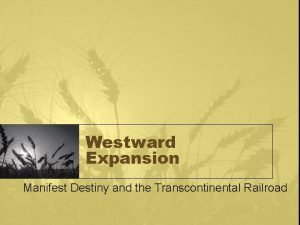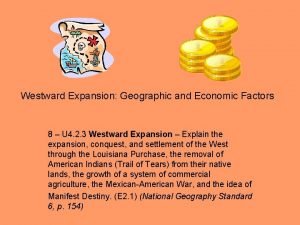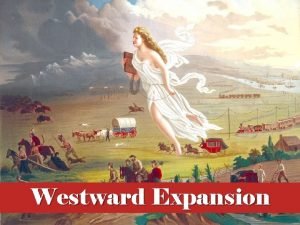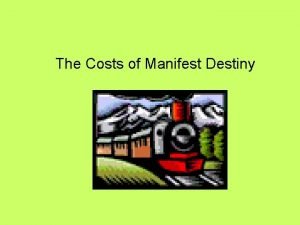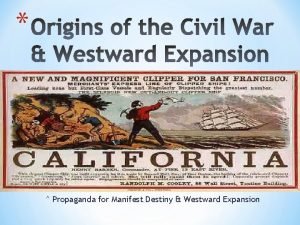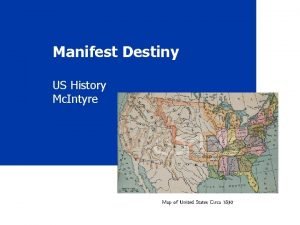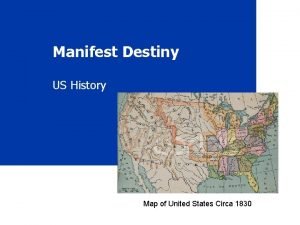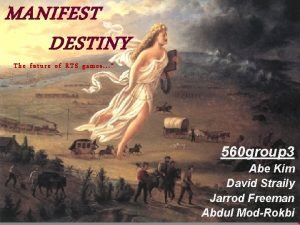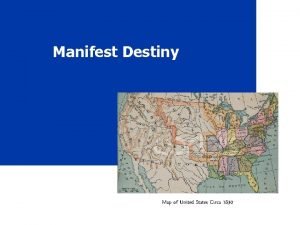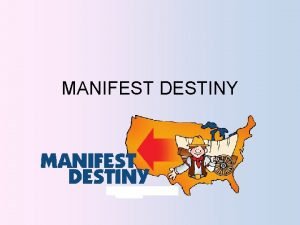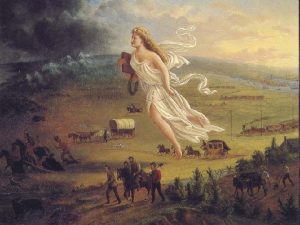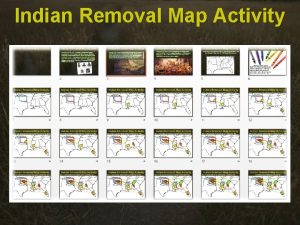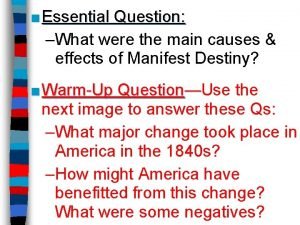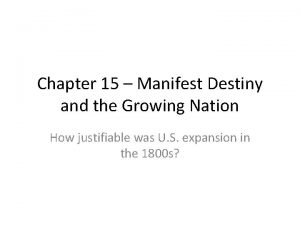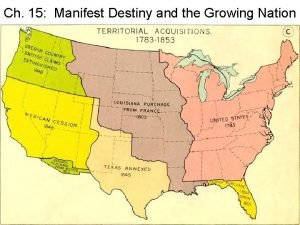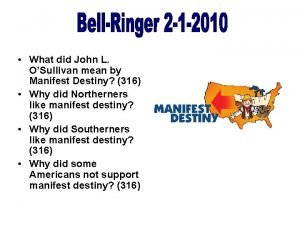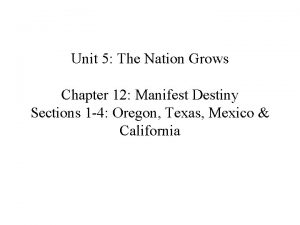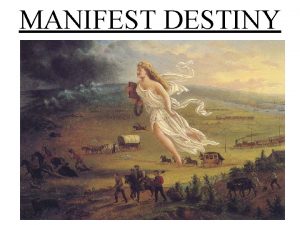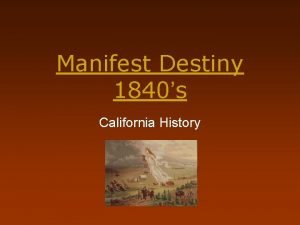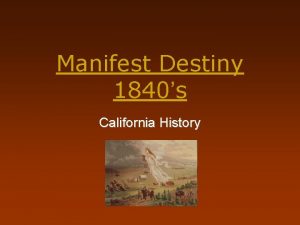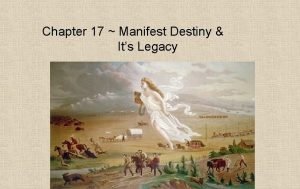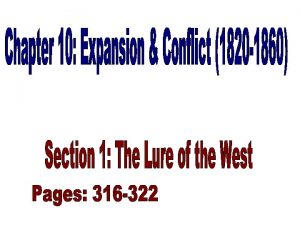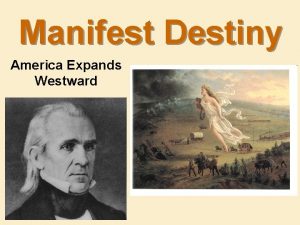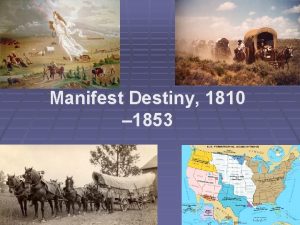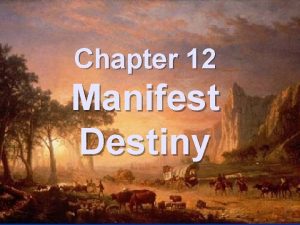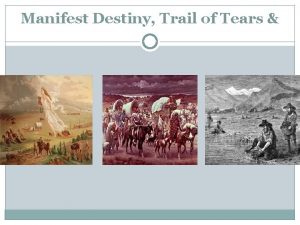MANIFEST DESTINY EXPANSION American History I Unit 7


























- Slides: 26

MANIFEST DESTINY & EXPANSION American History I - Unit 7 Ms. Brown

Review • What was the Market Revolution? What factors made it possible? • Shift to buying and selling goods (consumerism) – Industrial Revolution, specialization, capitalism, inventions, communication, transportation • Elias Howe invented the _____ which was later used in factories to mass produce clothes and shoes quickly and cheaply. • Sewing machine • What is the significance of the telegraph’s impact on communication? • Allowed people to communicate instantly • What were the benefits of using railroads to ship goods? • Could operate in the winter • Faster than canal shipping • Reliable when on schedule • Shipped goods to people who didn’t live near water • Which two inventions made farming possible and profitable in the Mid- West? • The steel plow and the mechanical reaper

7. 2 – MANIFEST DESTINY

Interest in the West • 1803 – TJ bought the Louisiana Territory Doubled the size of the US • Dreamed the US would become “an empire for liberty with enough room for our descendants to the thousandth and thousandth generation. ” • Many Americans began to believe that westward expansion was necessary and even ordained by God.

Manifest Destiny • The belief that it was America’s destiny (ordained by God) to expand westward to the Pacific Ocean • Manifest = obvious or inevitable • Destiny = fate or calling

WEST

Reasons to Move West • Escape debt and start fresh • Panic of 1837 left many people looking for a new beginning • Escape criminal past • Open land up for claiming • Land ownership = investment in the future • More space for growing population

Reasons to Move West • New markets to make money • New ports and harbors on the west coast (Pacific Ocean) to trade with Asia • Mining and farming in new lands • Maybe find gold • Spread Christianity and education to Natives • Escape religious persecution • Mormons moved westward and settled in Utah to escape religious discrimination in the east. • Spread democracy across the nation!

Case Study: Mormon Migration West • Mormons - members of the Church of Jesus Christ Latter -Day Saints, founded by Joseph Smith and his associates in 1830 • Reflective of the 2 nd Great Awakening religious movement • Mormons established largely self-sufficient communities in NY, OH, and IL • Essentially utopian, but successful • Constant movement due to discrimination – fear of growing Church and economic prosperity

Case Study: Mormon Migration West • 1844 - Navuoo, IL • Disagreements within the church and surrounding community resulted in Smith’s arrest and jailing. • Charges of polygamy, perjury, and inciting riots • An anti-Mormon mob broke into the jail and murdered Smith and his brother, Hyrum.

Case Study: Mormon Migration West • Brigham Young – Smith’s successor as leader of the LDS church, decided to move further west to escape religious persecution. • Created the “Mormon Trail” • 1847 – Young and the Mormons settled near the Great Salt Lake in (modern day) Utah. • Led to the development of Salt Lake City

Dangers of Moving West • Native American attacks • Unfamiliar seasons • One group called the “Donner Party” tried to take a shortcut and ended up stranded in the winter resorted to cannibalism • Mountains and dangerous terrain • Difficult for wagons to cross mountains and streams • Disease and illness • Drinking bad water (cholera), eating spoiled food • Measles • Running out of supplies or wagon breaking

Conflicts with Native Americans • As Americans moved westward, Native Americans viewed them as unwelcome invaders of their lands. • Some tribes assimilated into American culture. • Other tribes tried to fight to keep their land culture.

Conflicts with Native Americans • Early 1830 s – white settlers in Illinois and Iowa pressured Native Americans to move west of the Mississippi River. • Representatives of the tribe convinced Chief Black Hawk of the Sauk Tribe to lead a rebellion against the US.

Conflicts with Native Americans • 1831 -32 – Black Hawk War • Natives attacked Illinois militia members • Over 200 Native Americans were killed • Sauk and Fox tribes were forcibly moved west of the Mississippi River

Compromises with Native Americans • 1851 - The US government responded to settlers’ complaints about Native American attacks by calling a conference in Fort Laramie, Wyoming. • US representatives met with members of the Cheyenne, Arapaho, Sioux, and Crow tribes

Compromises with Native Americans • Treaty of Fort Laramie (1851) • Native American tribes given control of parts of the Central Plains and promised annual payments • Native Americans promised to stay away from white settlers moving west and government railroad projects

How to Move West • Covered wagon • Furs/cloth (for cold seasons) • Food (as much as you could carry) • Weapons, knives, guns (kill food and protection) • Basic medicine and first aid • Maps • Toolbox and grease bucket (for repairs) • Horse or mule to pull the wagon


How to Move West • Santa Fe Trail • Missouri to Santa Fe, New Mexico, used by many Americans to travel west • 780 miles • Wagons usually traveled in groups to avoid Native American attacks. • At night, wagons would circle-up to form a camp for security.

How to Move West • Oregon Trail • Missouri to Portland, Oregon, used by many settlers to move westward

How to Move West • Steamboats on rivers • Mississippi • Missouri • Arkansas • Colorado

How to Move West • Railroads (constantly being built and expanding west) • 1869 – Transcontinental Railroad finished • Dropped the price of traveling west from $1, 000 to $150.

Disputes in the Oregon Territory • Election of 1844 – James K. Polk (Democratic, Expansionist) vs Henry Clay (Whig) • Polk = 11 th POTUS!

Disputes in the Oregon Territory • US and Great Britain jointly occupied the Oregon Territory. • Polk’s campaign focused on gaining the land from GB. • 54º 40’ or Fight! – slogan adopted by the Polk campaign, referred to the latitude line 54º 40’ which created the northern border of the Oregon Territory

Disputes in the Oregon Territory • Mid-1840 s – GB lost interest in keeping the land • Fur trade declining • Didn’t want to spend money protecting the land • Polk decided land above the 49 th latitude line was not good for farming. • 1846 – US and GB agreed that the 49 th latitude line would be the US-Canada border.
 Jimmy fallon gadsden purchase
Jimmy fallon gadsden purchase Compromise enables maine and missouri
Compromise enables maine and missouri Manifest destiny railroads
Manifest destiny railroads Reasons for manifest destiny
Reasons for manifest destiny Essential questions for westward expansion
Essential questions for westward expansion Costs of manifest destiny
Costs of manifest destiny Westward expansion propaganda
Westward expansion propaganda Manifest destiny map
Manifest destiny map Manifest destiny map with dates
Manifest destiny map with dates Manifest destiny book
Manifest destiny book Map of us in 1830
Map of us in 1830 Growth of the united states to 1853
Growth of the united states to 1853 Does manifest destiny mean obvious fate
Does manifest destiny mean obvious fate What is the main idea of manifest destiny
What is the main idea of manifest destiny Manifest destiny book
Manifest destiny book Indian removal act map
Indian removal act map Reason for manifest destiny
Reason for manifest destiny Poem about manifest destiny
Poem about manifest destiny Slidell mission apush definition
Slidell mission apush definition Chapter 15 manifest destiny and the growing nation
Chapter 15 manifest destiny and the growing nation Facts about manifest destiny
Facts about manifest destiny Manifest destiny apush
Manifest destiny apush John l osullivan
John l osullivan Chapter 12 manifest destiny
Chapter 12 manifest destiny Manifest destiny effect
Manifest destiny effect Whats manifest destiny
Whats manifest destiny Manifest destiny
Manifest destiny


